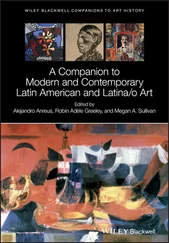A Companion to Arthur C. Danto
Здесь есть возможность читать онлайн «A Companion to Arthur C. Danto» — ознакомительный отрывок электронной книги совершенно бесплатно, а после прочтения отрывка купить полную версию. В некоторых случаях можно слушать аудио, скачать через торрент в формате fb2 и присутствует краткое содержание. Жанр: unrecognised, на английском языке. Описание произведения, (предисловие) а так же отзывы посетителей доступны на портале библиотеки ЛибКат.
- Название:A Companion to Arthur C. Danto
- Автор:
- Жанр:
- Год:неизвестен
- ISBN:нет данных
- Рейтинг книги:5 / 5. Голосов: 1
-
Избранное:Добавить в избранное
- Отзывы:
-
Ваша оценка:
- 100
- 1
- 2
- 3
- 4
- 5
A Companion to Arthur C. Danto: краткое содержание, описание и аннотация
Предлагаем к чтению аннотацию, описание, краткое содержание или предисловие (зависит от того, что написал сам автор книги «A Companion to Arthur C. Danto»). Если вы не нашли необходимую информацию о книге — напишите в комментариях, мы постараемся отыскать её.
Companion
A Companion to Arthur C. Danto
A Companion to Arthur C. Danto — читать онлайн ознакомительный отрывок
Ниже представлен текст книги, разбитый по страницам. Система сохранения места последней прочитанной страницы, позволяет с удобством читать онлайн бесплатно книгу «A Companion to Arthur C. Danto», без необходимости каждый раз заново искать на чём Вы остановились. Поставьте закладку, и сможете в любой момент перейти на страницу, на которой закончили чтение.
Интервал:
Закладка:
Danto scoffs at this “hyperaesthetic, precious view of art and artistic creativity” (1975, 31), but he takes the metaphysical point: artworks are not real things exactly; they are not ordinary objects with extraordinary “aesthetic” properties added on. Staircases in fictions have no determinate number of steps (unless specified), nor is a song quite the same thing as the sounds one hears when one hears the song. This is very like saying, as Danto does elsewhere, that even if Andy Warhol’s Brillo Box had been qualitatively identical to actual Brillo boxes – indeed, if Warhol had simply put actual Brillo boxes in the gallery, instead of the wooden, silkscreened facsimiles he manufactured – they would still be, thanks to the “atmosphere of theory” surrounding them, works of art and not just (plain old) Brillo boxes. Like persons, which are not, pace Descartes, mere combinations of minds and bodies, artworks are “irreducible to parts of themselves, and are in that sense primitive” (Danto 1964, 576). Persons and artworks belong to a category of things distinct from ordinary objects, and for this reason Danto acknowledges the plausibility of Sartre’s view, “as a matter of ontology” (1975, 31).
That allusion, however, that hint of an affinity between Sartre’s early notion of the ideality (or virtuality) of art and literature and Danto’s theory of artworks as constituted by their participation in the artworld, comes and goes in the opening chapter of Jean-Paul Sartre without explicit discussion. More significant are Danto’s occasional references, in this book and elsewhere, to the mature ontology of Being and Nothingness , in particular the distinction between “being-for-itself” ( être-pour-soi ), which describes the negative reflexive relation in which consciousness stands to itself, and “being-in-itself” ( être-en-soi ), the being of things constituted positively by their objective properties. The distinction is a refined version of what is more commonly known as the difference between subjectivity and objectivity, or the inner and the outer, and it lies at the heart of Sartrean existentialism. It also runs parallel to one of Danto’s central insights: that artworks externalize and concretize “styles” or ways of seeing the world that in their original, naive occurrence necessarily remain transparent to those whose styles and perspectives they are.
How far does Danto’s theory of artistic style run parallel to Sartre’s ontological categories? To find out, we need to define a few more terms. To say that human consciousness exists pour-soi is to assert that its structure consists in its prereflective, “nonthetic” awareness of itself, which Sartre distinguishes from the explicit “thetic” knowledge one comes to have of oneself qua object. Sartre calls the latter connaissance de soi , the former conscience (de) soi – the parentheses around the de forestalling any suggestion of division or duality, since the self at this primitive level just is (that is, coincides with) immediate consciousness (of) itself. This unified “prereflective cogito ,” as Sartre calls it, precedes and makes possible psychological and otherwise empirical self-knowledge, which is on all fours with our knowledge of others. For what I can say of myself qua object, others can as easily say by referring to me by name or in the third person: “He is happy” says of me what I say when I report that I am happy, but “He is sorry” says less or other than what I say when I express my regret by apologizing. To apologize is not just to say but to show that one is sorry. And just as Wittgenstein (1958, 66) proposes that “I” should therefore be understood as having two cases, subjective and objective – for avowals and ascriptions, respectively – so the pour-soi has two aspects, what Sartre calls transcendence and facticity . The transcendence of consciousness is its direct relation to a world beyond or external to itself, a relation that is at once a reflexive relation to itself. The facticity of consciousness, by contrast, is its quasi-objective aspect, its inescapable exposure to the consciousness of others, as well as to itself from a reflective, third-person point of view.
Although Sartre is not entirely consistent on this point, it is crucial to his system that the aspectual or perspectival distinction between transcendence and facticity not be conflated with the ontological distinction between pour-soi and en-soi . Facticity is not the brute objectness of the en-soi , but rather one of the essentially personal dimensions of the pour-soi . Or better, it is consciousness qua object in the grammatical sense of accusative , or target of awareness, not the metaphysical sense of (mere) thing with properties. Our facticity is our third-person presence to ourselves and others – but the person in the phrase “third-person” is crucial: encountering someone, even in an objectifying way, whether in love or in hate, desire or contempt, is fundamentally unlike encountering an inanimate object. Sartre sometimes talks as if we are doomed to regard each other as either radically incommensurable, inscrutable subjects or just brute things, inert flesh. But any inclination to that kind of literal reification could only yield a bizarre caricature of interpersonal relations, for in real life we experience ourselves and others not as brute stuff, but as vulnerable, sensitive, exposed to one another’s awareness. My primitive sense of others, Sartre famously says, is an acknowledgment of them not as objects in my world, but as subjects: they see me . The so called problem of other minds can therefore never be a real epistemic problem, for my knowledge of others has always already been shaped by my apprehension of their apprehension of me. Doubt necessarily comes too late. Moreover, arguably the deepest insight in Sartre’s account of our being “for others” ( le pour-autrui ) is precisely that the only objectivity consciousness has, or can have, is the external surface it presents to the consciousness of another. Without other persons in my world, my own consciousness would be so transparent as to be invisible, even to myself – like Schopenhauer’s eye that does not see itself. The ethical and epistemological implications of Sartre’s phenomenology of “the look” ( le regard ) are profound, but the metaphysical picture framing it must be kept firmly in view: ontologically speaking, others are not and cannot be mere things ( en-soi ) for my gaze, nor am I or can I be a mere thing ( en-soi ) for theirs.
The “nothing” in Being and Nothingness thus refers to the ontological subjectivity of the pour-soi as such, but also to the practical and epistemic transparency of our transcendence toward the world. To say that consciousness is nothing is to say that it is never the kind of something that can be defined simply by its positive objective properties, but we are also each of us nothing in a more refined sense, namely, that however we might be described from a third-person point of view – whether in physical or psychological terms, as embodied agents, as creatures or persons with thoughts and feelings – all such factical attributes necessarily fall short of and at the same time presuppose the immediate relation we have to ourselves when we have the world itself directly in view, that is, when we are transparent to (and in a certain sense, absent from) ourselves. Sartre’s notion of transcendence is thus akin to G. E. Moore’s claim that sense experience is “diaphanous,” so that, for example, “when we try to introspect the sensation of blue, all we can see is the blue” (Moore 1993 [1903], 41). Gareth Evans argues that the same is true of belief: if someone asks me if I think there will be a third world war, “I must attend, in answering him, to precisely the same outward phenomena as I would attend to if I were answering the question, ‘Will there be a third world war?’” (1982, 225).
Читать дальшеИнтервал:
Закладка:
Похожие книги на «A Companion to Arthur C. Danto»
Представляем Вашему вниманию похожие книги на «A Companion to Arthur C. Danto» списком для выбора. Мы отобрали схожую по названию и смыслу литературу в надежде предоставить читателям больше вариантов отыскать новые, интересные, ещё непрочитанные произведения.
Обсуждение, отзывы о книге «A Companion to Arthur C. Danto» и просто собственные мнения читателей. Оставьте ваши комментарии, напишите, что Вы думаете о произведении, его смысле или главных героях. Укажите что конкретно понравилось, а что нет, и почему Вы так считаете.












